
Show Interrupted: Covid-19
Cast members of the Syracuse Stage production of “Amadeus.” March 11 – 29, 2020. By Peter Shaffer. Directed by Robert Hupp. Photo: Mike Davis
Robert Hupp and Jill Anderson
On the morning of Monday, March 9, 2020, artistic director Bob Hupp and managing director Jill Anderson met in the Syracuse Stage conference room with Board of Trustees chair Rick Shirtz, Board president Bea González, Board member Richard Driscoll, and a small number of the Stage senior staff. One topic filled the agenda: Covid-19.
For three weeks prior, Hupp had been engaged in rehearsals as director of Peter Shaffer’s Amadeus, with Jason O’Connell cast as Salieri and Mickey Rowe returning to Stage in the role of Mozart. The weekend had been consumed with technical rehearsals for the show, but consuming everyone’s attention was the unprecedented impact of the Covid-19 virus. The news was grim.
Within a week, New York Stage would declare a state of emergency. On March 12, Broadway shuttered all theatres. Carnegie Hall, The Metropolitan Opera, and The Metropolitan Museum also closed. Sunday, March 15, brought news of the first five Covid-related deaths in New York State. González, who at the time was Syracuse University’s vice president for community engagement, emphasized that the University administration was anticipating and preparing for the worst. Hupp determined Syracuse Stage should do the same. Amadeus would perform the two scheduled previews on Wednesday and Thursday, then open and close on Friday. Ever attentive to providing the best for Stage patrons, Hupp also decided to video the preview performances for those who would not have the opportunity to see Amadeus live. With help from WCNY and Black Cub Productions, Amadeus became the first in what would be a series of video productions that Stage offered throughout the pandemic.
The cast of "Thoughts of a Colored Man" in the world premiere at Syracuse Stage. September 4 - 21, 2019. By Keenan Scott II.
Until that point, the season had been a resounding success, a continuation of the momentum accrued through the previous season as the celebrity buzz generated by Jason Alexander in June gave way to a buzz of a different sort in August with the season opener, the world premiere of Keenan Scott II’s Thoughts of a Colored Man. As Hupp explained in his program note, Thoughts of a Colored Man was an “enhanced” production, meaning it was developed in partnership with commercial producers, in this case Brian Moreland and the late Ron Simons, Broadway veterans both, who had a clear goal of moving the show to New York. With Steve H. Broadnax III directing, the rehearsal and performances at Syracuse Stage proved a fundamental steppingstone in the play’s development. In October of 2021 as New York theatres resumed live performance, Thoughts of a Colored Man opened on Broadway at the Golden Theatre. It was first Broadway play written and directed by Black men with a Black man in the lead. It was also among the first plays to open on Broadway post-pandemic. It was the first Broadway transfer for Syracuse Stage since Twice Around the Park in 1982.
The two shows following Thoughts of a Colored Man proved immensely popular with Stage audiences. Reginald Rose’s Twelve Angry Men, co-produced with Indiana Repertory Theater, arrived with a veteran cast whose pitch-perfect performances illuminated the play’s startlingly contemporary resonance. Originally written as a television drama in 1954, Rose’s taught drama confronts head-on the racism that infects—and attempts to derail—a system that promises equal justice for all.
Hanley Smith, Ken Wulf Clark, Adrian Lee, and Marisa Field in "The Last Five Years" at Syracuse Stage. May 29 - June 16, 2019. By Jason Robert Brown. Directed by Jason Alexander. Photo: Mike Davis
The annual holiday co-production with the Syracuse University Department of Drama welcomed families with an outstanding production of Disney’s Beauty and the Beast, directed by Donna Drake with choreography and fight choreography by Anthony Salatino and music direction by Brian Cimmet. Driven by the powerful vocals of Ezekial Andrew as Beast/Prince and an outstanding cast, including Drama student Stephanie Craven as Belle, the show played to full or nearly full houses throughout its entire run. Many mini-Belles, some young Princes, and even a diminutive Gaston were spotted in the audience as children dressed the part for their visit to Syracuse Stage.
For the season’s next show, Syracuse Stage moved from the Archbold Theatre to the Storch, which was transformed into an indoor soccer field for Sarah DeLappe’s play The Wolves. A frank and moving look at a high school girls soccer team, the play was “a story filled with young women in which they weren’t girlfriends or daughters or love interests or sexual objects, but where they were athletes. Where it was about their bodies, but their ownership of their own bodies, and the strength of their own bodies,” as the playwright noted.
Next came March and the global shutdown: just the three performances of Amadeus, then nothing more live on stage until the fall of 2021.

Cast members of the Syracuse Stage production of “Amadeus.” March 11 – 29, 2020. By Peter Shaffer. Directed by Robert Hupp. Scenic design by Misha Kachman. Costume design by Tracy Dorman. Lighting design by Dawn Chiang. Sound design by Victoria Deiorio. Hair and wig design by Robert Pickens. Photo by Mike Davis.
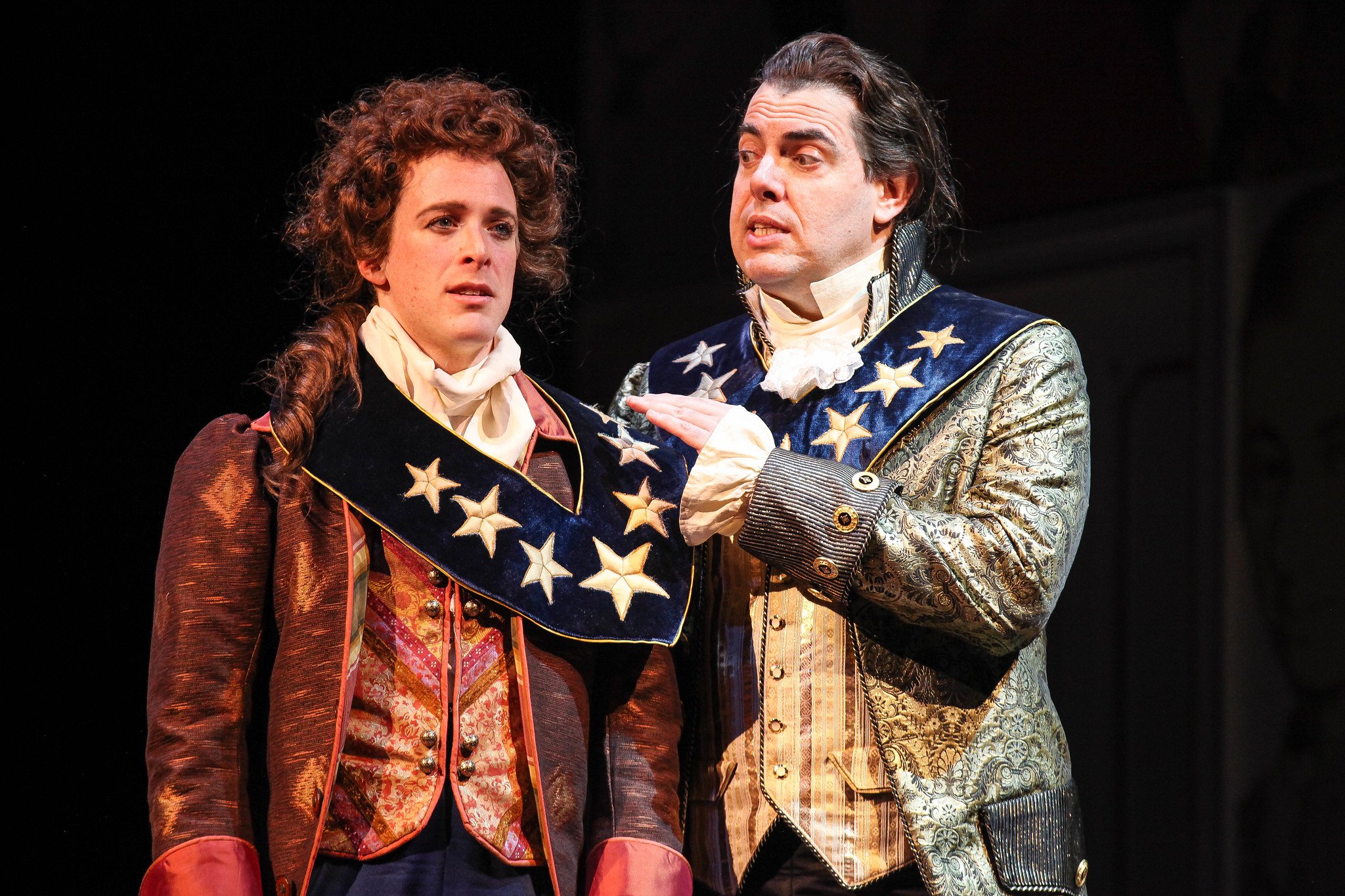
Mickey Rowe and Jason O'Connell in the Syracuse Stage production of “Amadeus.” March 11 – 29, 2020. By Peter Shaffer. Directed by Robert Hupp.

Cassia Thompson, Maggie McPherson, Ali Whitwell, and Alessandra Casanova in the Syracuse Stage production of "The Wolves." January 22 - February 16, 2020. By Sarah DeLappe.

Cast members in the Syracuse Stage production of "Disney's Beauty and the Beast." November 22, 2019 through January 5, 2020. Directed by Donna Drake.
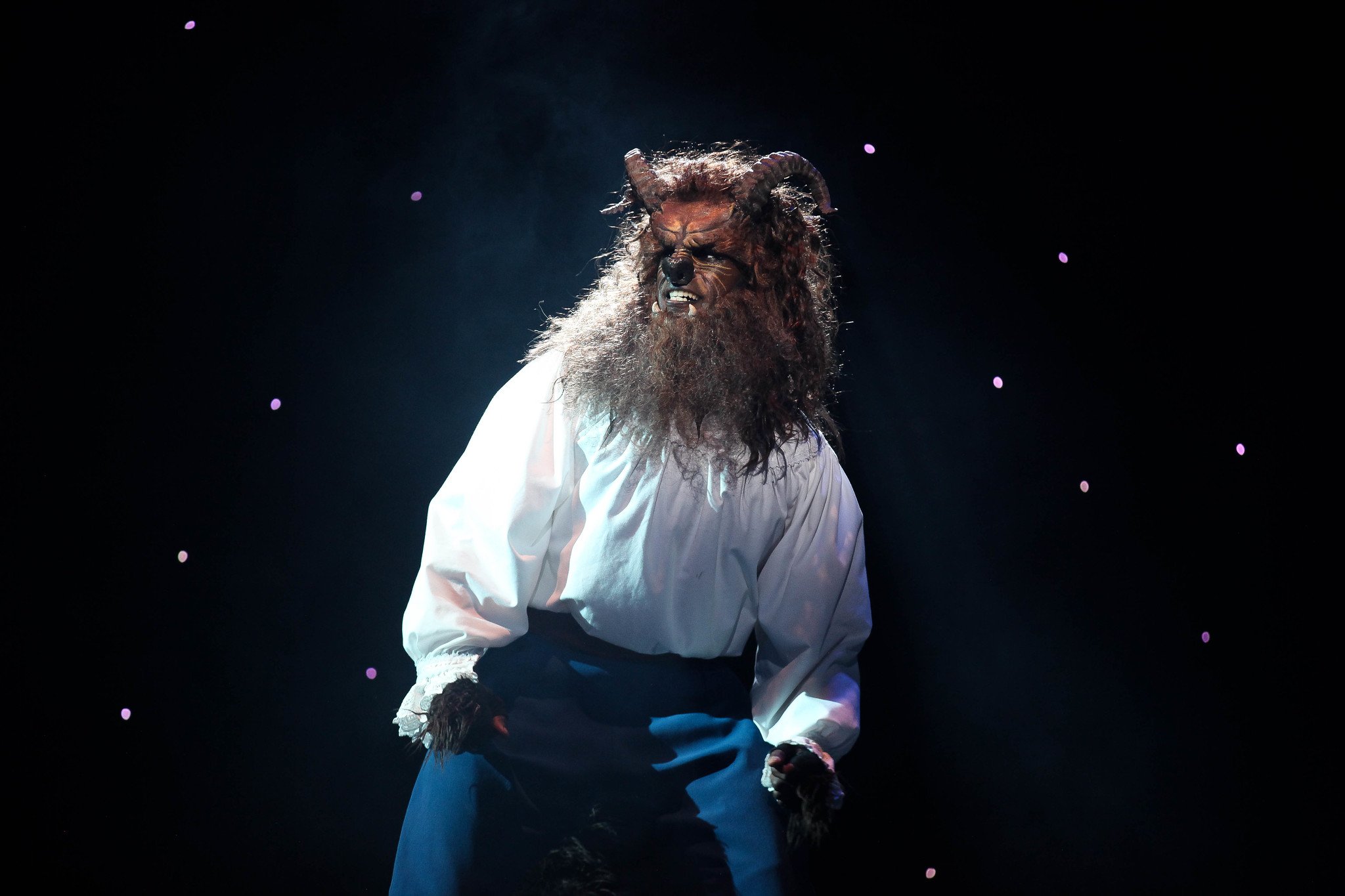
Ezekiel Andrew in the Syracuse Stage production of "Disney's Beauty and the Beast." November 22, 2019 through January 5, 2020. Directed by Donna Drake.
PIVOT
As of April 2024, reported fatalities due to Covid-19 exceeded 7 million worldwide with more than 1 million in the United States. The majority of the deaths in the US occurred between January 2020 and September 2021. Virtually no one was immune from the physical and mental impacts of the virus, including the staff of Syracuse Stage. Tough decisions needed to be made. Some theatres simply shut down, furloughing employees and suspending all operations. That option was never seriously considered at Syracuse Stage.
While canceling most of the run of Amadeus was deeply disappointing, the video produced and distributed to subscribers and single ticket holders and made available to all others for purchase online revealed two instructive points. First, in Eric Derachio Jackson and Mylz Blake, the team at Black Cub, Stage had excellent partners for turning stage plays into video productions. Second, because the Amadeus video could be accessed from anywhere, Syracuse Stage could reach audiences beyond Central New York. More than 1,700 people representing 49 states and four countries viewed Amadeus online. Significantly, the production caught the attention of the late Terry Teachout, then theatre critic for the Wall Street Journal, who wrote: “[the show] is a triumphant demonstration—the best I’ve seen to date—of how soul-satisfying a theatrical webcast can be. Syracuse Stage’s revival of Peter Shaffer’s Amadeus, directed by Robert Hupp, is a thrilling staging of one of the finest English-language plays of the 20th century, and it comes across online with exhilarating clarity.”
Welcome as these bright lights were, they could not forestall nor alleviate the gathering gloom of unrelieved uncertainty. The unanswerable question governing and undermining every conversation and every decision was how long would the theatre be shut down. It was simply impossible to know, and therefore impossible to plan. Theatre is not created on the fly; a Syracuse Stage production typically requires months of preparation, much of that time spent with people working in close physical proximity. How could sets and costumes be built? How could actors and musicians rehearse? When would audiences be allowed back, and more importantly, when would artists and patrons feel safe enough to return? When Governor Cuomo announced the Broadway shutdown on March 12, he said it could last longer than a month. A month later it was clear no one knew what was ahead.
With a certain amount of optimism, Hupp and the staff initially held onto the possibility that at least one of the two shows remaining in the season—Once and Yoga Play—might find its way to the stage. The best chance lay with Once, which was co-production with Rochester’s Geva Theatre Center and had already opened there. It could be restaged with limited rehearsal. However, as reported cases and fatalities continued to rise, it became apparent that the 2019/2020 season was over. It was time to pivot to a new plan, then pivot again, and pivot again.
A Season and Theatre Reimagined
Prior to the shutdown, Stage had announced the shows for the 2020/2021 season: Mary Shelley’s Frankenstein, Matilda The Musical, Eureka Day, Once on This Island, Our Town, and salt/city/blues. The suspension of the 2019/2020 season meant that proposed line-up also had to be rethought. In order to try to honor commitments to the artists and crews contracted for the cancelled shows, it was decided that Once would move to September of 2020 as a late conclusion to the 2019/2020 season and Yoga Play would replace Eureka Day in the 2020/2021 season. The plan called for providing online video productions for each show until live performances would again be possible. However, producing that line-up and the expectation that live performance would return proved chimeric.
By June of 2020, it was clear that live performance would not resume in the fall. Some Broadway producers expressed hope for December openings while prominent organizations such as New York City Ballet and Radio City Music Hall announced the cancelations of their popular Christmas productions. If performing live in September was no longer possible, the season would have to be reconsidered—again, and reconsidered in the light of a multiplicity of uncertainties. How long would live performance be prohibited? Already some were suggesting a year to 18 months. What guidelines would govern the working conditions for actors, directors, and crew if productions could go forward? As the pandemic worsened, the guidelines imposed by the unions continually shifted and became understandably more rigid. Would audiences support online productions? Patron response was very mixed. Moreover, while Amadeus had achieved a certain kind of success, it generated a meager fraction of the revenue of live performance, as would any future videoed production. The additional costs of video were high and the potential income low, certainly not an indefinitely sustainable model.
Still, there were indicators that supported proceeding with a season. First, the Department of Drama intended to mount physical productions throughout the 2020/2021 academic year even if no audiences would be allowed to see them. The experience of performing was considered a pedagogical necessity. This meant that the technical shops and crews would be needed to build sets, props, and costumes and provide lighting and sound. In other words, the shops would be working whether or not Stage continued producing. Second, Stage’s eligibility to receive funding from the Payment Protection Program and Save Our Stages would help offset the loss of revenue. The prospect of keeping staff members employed while continuing to produce theatre for Stage’s loyal patrons were powerful incentives despite the ongoing and ever-changing challenges, not all related to Covid.
On May 25, George Floyd was murdered by a Minneapolis police officer. A video showing the officer, Derek Chauvin, with two other officers, pinning Floyd to the ground, Chuavin with his knee on Floyd’s neck for more than nine minutes as he expired, went viral and prompted widespread protest and once again calls for meaningful change. Many theatres and arts institutions issued statements condemning racism and supporting the BlackLivesMatter movement. On May 31, Syracuse Stage published the following statement signed by Hupp and Anderson on behalf of the organization:
We stand in solidarity with those who protest today for justice. We condemn racism. We are horrified by the murder of George Floyd and the cycle of violence perpetrated against Black Americans. We stand with our neighbors in Syracuse who gather in the hope of a better tomorrow.
As an institution, we acknowledge that we need to listen, to learn, to be more effective allies in this cause. In this moment in time, we must use our power as storytellers to shift the narrative, we must lead by example to combat racism. We must lift up the many voices in our community. We will do better.
In early June, the coalition of artists known as We See You White American Theatre issued a lengthy statement criticizing the entrenched systemic racism in American Theatre from Broadway to regional companies and calling for significant changes in artistic programming, hiring practices of artists and staff, and institutional culture. Even given the challenges of Covid, Stage leadership was determined to incorporate the recommendations of We See You White American Theatre in developing plans for the future.
Jason O'Connell and Kate Hamill in "Talley's Folly," the first mainstage production in Syracuse Stage's virtual 2020/2021 season. By Lanford Wilson. Directed by Robert Hupp. Photo: Brenna Merritt
The summer of 2020 represented the peak of the pandemic. Any hope that the shut down would be short was gone; any doubt that the health threat was critical was folly. As theatres tried to reopen, Actors’ Equity prioritized health and safety, and with no precedent for guidelines, left it to theatres to develop safety plans and then submit them for approval. As of July, Equity had only approved two productions. The difficulty of working safely was particularly acute for musicals. Large casts meant that maintaining safe distances would be impossible, dancing and singing would be unbearable while wearing masks and especially worrisome without, and in orchestra pits reed and brass players clearly could not be masked. The three planned musicals—Once, Matida The Musical, and Once on This Island—would have to scrapped. Small scale shows that might work well on video would have to substitute.
Therefore, in August, Stage announced another pivot, a reimagined season available online as long as necessary and live as soon as possible. In affirming the commitment “to be more effective allies” in the fight against racism and to “lift up the many voices in our community,” the season expanded to include community focused “Syracuse Stories” and increased discussion opportunities through a series called “Engage with Stage.”
The new season now included Lanford Wilson’s Talley’s Folly; Lauren Gunderson and Margot Melcon’s Miss Bennet: Christmas at Pemberley; Anna Devere Smith’s Twilight: Los Angeles, 1992; and the previously announced Yoga Play, Our Town, and salt/city/blues. Specifics of other programming were also announced. The first Syracuse Story would be an original new play called A Gatherin’ Place written and performed by members of The Harriet Tubman Troupe and starring and directed by Dr. Juhanna Rogers. Co-produced with Auburn Public Theatre, the play was performed and videoed in the Archbold Theatre. The Archbold also served as the location a series of recorded community focused conversations sponsored by 100 Black Men of Syracuse.
The amount and variety of programming Stage scheduled throughout the lockdown offered an appealing array of experiences. Kyle Bass and Ping Chong hosted a zoom reunion with the cast of Tales from the Salt City. Actor, playwright, and military veterans’ advocate Stephan Wolfert became an artist-in-residence and developed a new work The Head of Richard based on Shakespeare’s Richard III. Cold Read featured a new translation of Medea by poet and Syracuse resident Charles Martin. A companion series Cold Read Shorts periodically presented work by a variety of artists including Bass and Carrie Mae Weems. Additionally, Stage made available two performances developed by others. In September, patrons were given access to a radio adaptation of Sinclair Lewis’ 1935 novel It Can’t Happen Here, produced by Berkely Repertory Theatre and starring academy award nominee David Straithairn. For the holidays, Estella Scrooge: A Christmas Carol with a Twist featured a cast of Broadway veterans and cutting-edge animation to create an updated version of Dickens’ classic tale.
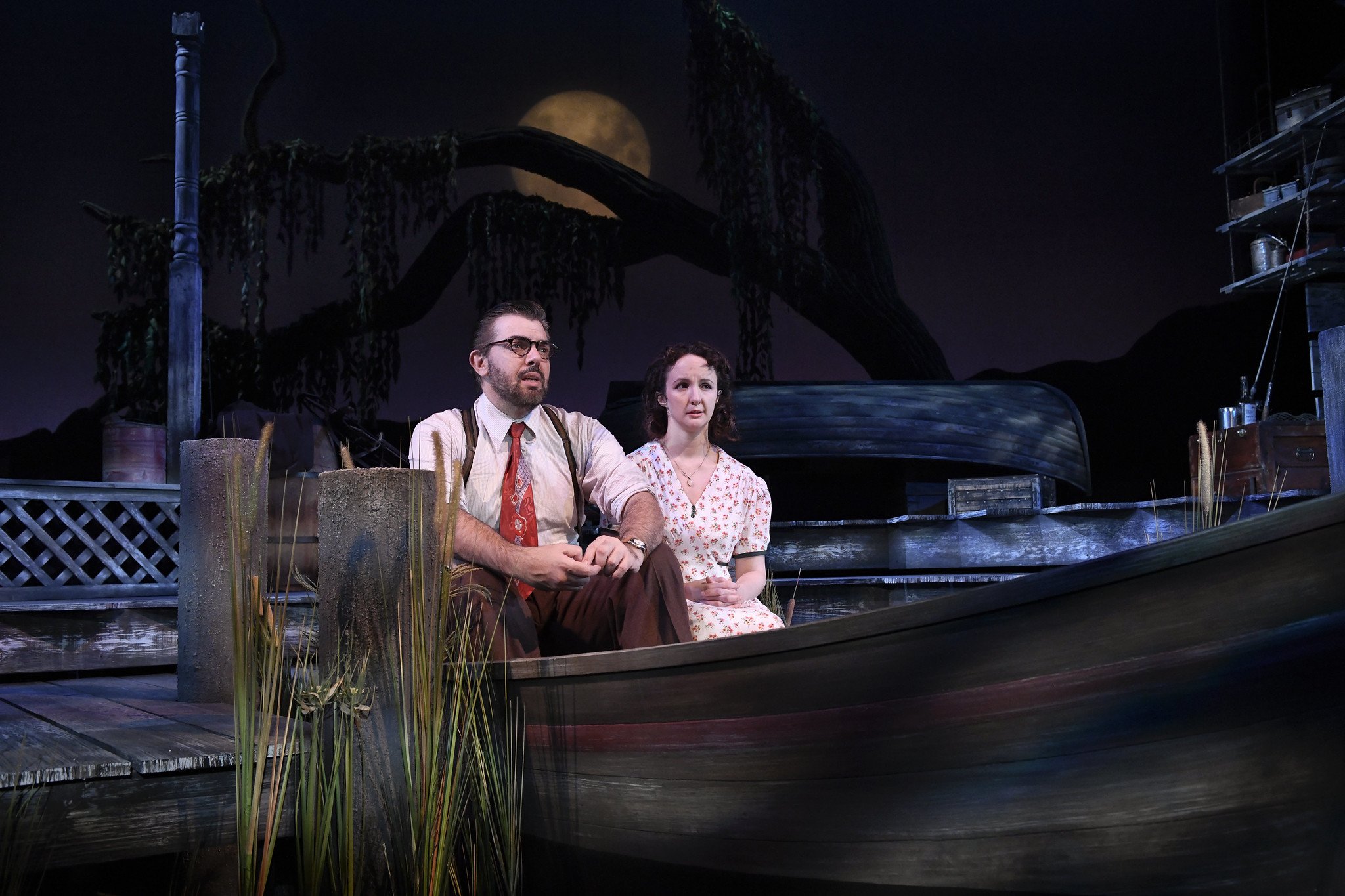
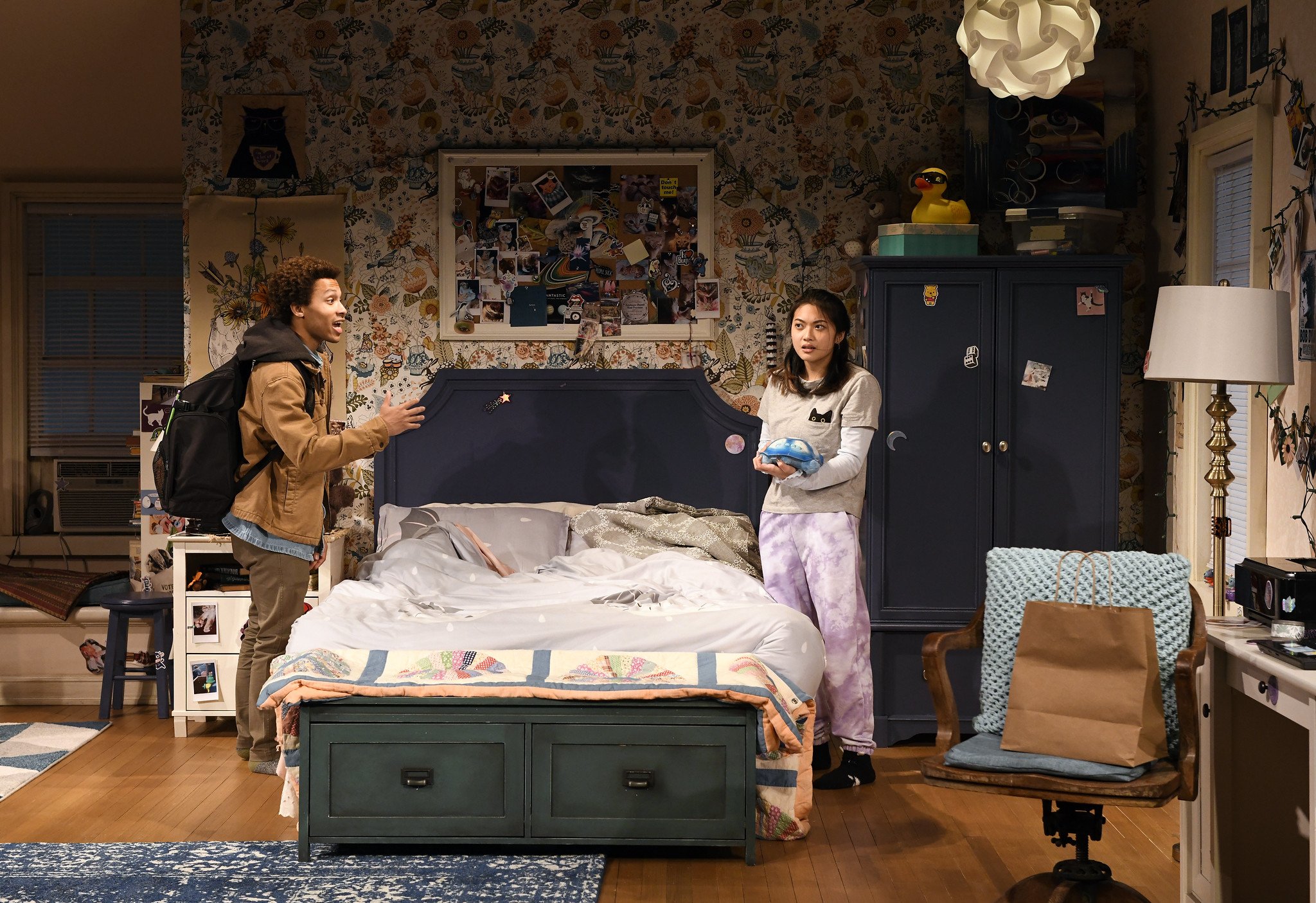
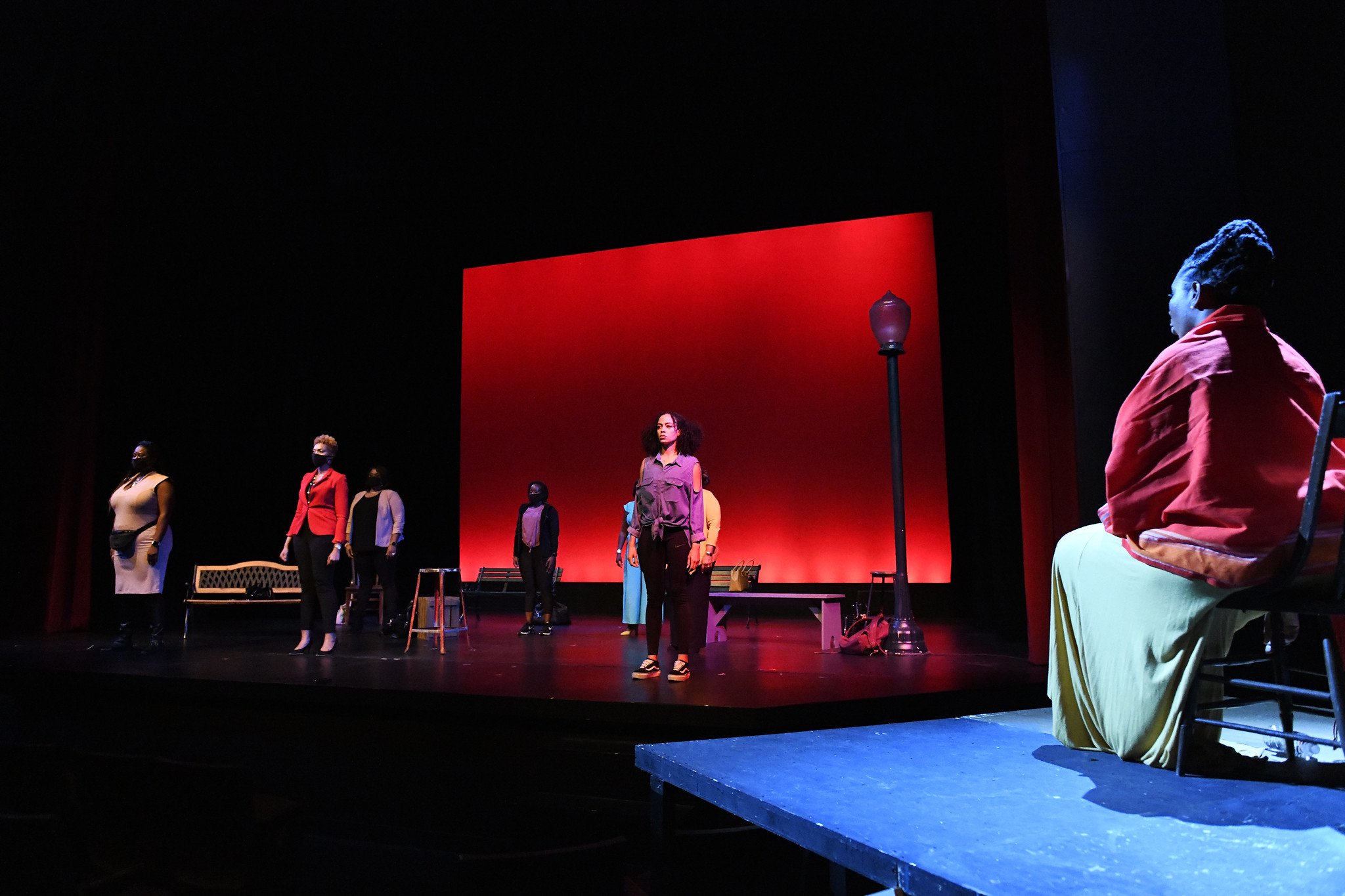
What would normally be considered the mainstage season got underway in October with rehearsals of Talley’s Folly, Lanford Wilson’s Pulitzer Prize winning comedy about an awkward romance between a thirty-something woman from the Bible Belt and a big city accountant ten years her senior. With one set and only two characters, the play could work well on video. At the time, Equity was tracking the number of cases in each region to determine whether or not to grant permission for actors to work. Syracuse and Central New York were faring better than other places, and Equity gave the go ahead. But how best to minimize the risk of exposure for the visiting artists? The answer arrived in the persons of Kate Hamill and Jason O’Connell, two actors with previous experience at Stage (as Salieri in Amadeus, O’Connell had spoken the last words from the Archbold Stage) and who were also a married couple. They could live and work together, and thereby limit their exposure to others. The plan worked well. Directed by Hupp, Hamill and O’Connell delivered exceptional performances, captured by Black Cub, and released online in late November. Again, Terry Teachout took notice calling the production a “touching two-actor triumph” in his Wall Street Journal review.
However, Covid numbers were rising steadily. In response, Equity issued new safety guidelines that made it impossible to proceed with Miss Bennet: Christmas at Pemberley. The new guideline essentially stated that actors could participate in video productions only from the safety of their own homes. Miss Bennet had a cast of eight. Even with the magic of video, there was no way record the play over eight locations. Once again, the announced season would have to change.
As students of theatre learn, an important rule of improvisation is truthful acknowledgement of the immediate circumstances. In this instance, the unassailable circumstance was that just about everyone would now be (stuck at) home for the holidays. Rather than give up and abandon the holiday show, Hupp turned to Department of Drama faculty member Ricky Pak who proposed embracing the spirit of being home for holidays. A versatile theatre artist, Pak had experience devising new work and called on fellow faculty members, some Drama students, and professionals from previous Syracuse Stage shows to create an evening of story and song appropriately called Home for the Holidays. With music director Brian Cimmet at the piano, the company, all safely in their own homes, reflected on the meaning of the holidays, past and present, and shared memories and songs, using zoom to record the performances.
The remarkable actor Patrese D. McClain, scheduled to portray the 37 characters in Anna Deavere Smith’s solo show Twilight: Los Angeles, 1992, made her home in Chicago. Since she was now prohibited from coming to Syracuse for the show, the show would have to go to her. It was time to get creative. First, how to address the restriction on location. McClain’s apartment was not suited to accommodate the equipment necessary to record the show comfortably. However, an art gallery, shuttered for the pandemic, was located on the ground floor of her building. It was available. If the space wasn’t exactly McClain’s domicile, she could still rehearse, perform, and record Twilight without technically leaving her place of residence. Next, Stage sent company manager Brian Crotty to Chicago with all the equipment needed for the show. Crotty and McClain never met in person and were never in the gallery at the same time. He set up the necessary equipment and stayed in the city to assist if needed. Then the creative team connected to rehearsals via zoom and went to work with McClain. As Bob Hupp noted in his program note for the show: “One actor, working alone in a room outfitted with a green screen, created 37 distinct and diverse characters. Our actor, the remarkable Patrese D. McClain, lives in Chicago. Our director and sound designer worked from State College, Pennsylvania, while our video, scenic, lighting, costume, and wig designers, as well as our dialect coach, worked from New York City. Our stage manager called the show from Long Island and our resident production team coordinated the project from Syracuse.” It was an extraordinary achievement accomplished by McClain and director Steve H. Broadnax III, designers Michael Carnahan (scenic), Emilio Sosa (costumes), Alan C. Edwards (lighting), Curtis Craig (sound and composer), Katherine Freer (video), Nikaya Mathis (wigs), dialect coach Christopher Berry, and stage manager Laura Jane Collins. Twilight spoke with a clarity and truth as if it had been written for 2020 and not 1992. Even without a live audience or a stage, Smith’s text and theatre itself maintained relevancy. That was the good news.
The bad news (never far away during Covid) was that the season once again would have to change considerably. The prohibition on bringing actors to Syracuse to rehearse and perform meant the three remaining shows in the season—Yoga Play, Our Town, and salt/city/blues--would have to be changed. No one could say with anything approaching certainty when the restriction would be lifted. The reimagined season would have to be reimagined again.
Though named after a notoriously dangerous mountain range in Nepal, Sharr White’s comedy Annapurna is about an estranged couple who reunite in a trailer in Colorado. The trailer is where the estranged husband Ulysses has been living rather badly for some time. An unexpected visit from his ex-wife Emma affords an opportunity to re-examine their past together. The entire play takes place in the trailer.
Stephan Wolfert, an actor and writer, had been at Stage in the fall as an artist-in-residence to develop a new play based on Richard III. He had been joined in that endeavor by his wife Dawn Stern. The new play, The Head of Richard, was developed as part of Wolfert and Stern’s work with their company DE-CRUIT, a program using science and Shakespeare designed to aid veterans suffering from trauma. As this work takes the couple all over the country, they have no permanent residence. They live in a specially outfitted van, which affords them maximum flexibility to travel. If life is not necessarily stranger than fiction, it certainly can be more coincidental.
Hupp contacted Wolfert and Stern about doing Annapurna. Would they be willing to drive the van to Syracuse and allow it to be used as the set? They agreed. Once in Syracuse, the van was parked on a sound stage, modified, and fitted with small cameras hidden throughout to provide multiple simultaneous captures of the performance, which were then edited into the final version for online distribution in mid-March, one year after the shutdown.
At the heart of Annapurna is a mountaineering concept called “committing.” It means pushing forward beyond a point of no return where the only option is to push forward. In a joint program letter, Anderson and Hupp detailed some of the pandemic’s impact on Stage: eight shows canceled or postponed, $2 million decrease to the budget, and a loss of 3,000 subscribers. Still, Stage maintained full employment and was more than half-way through providing a full online season. With a year gone and uncertainty ahead, the concept of “committing” seemed not only the best option, but the only one.
For the last two shows of the season, actors were allowed to rehearse and perform in Syracuse. The Storch Theatre became the video “studio” as Melissa Crespo directed Lauren Gunderson’s I & You. The show represented a reunion of sorts as Crespo assembled the same design team she had used for Native Gardens: Shoko Kambara (scenic), Lux Haac (costumes), Dawn Chiang (lighting) and Elisheba Ittoop (sound and original music). Built around the physical and metaphysical interconnectedness expressed in Walt Whitman’s “Song of Myself” and discovered in the play by two high school students working together on a homework assignment, the show had a particular resonance during the pandemic, as Crespo explained: "This past year has revealed how dangerous isolation can be to the human spirit. We are social creatures and our survival depends not only on physical health, but from deep emotional connections with others.”
Nick Apostolina, Phumzile Sojola, and L. Peter Callender in Syracuse Stage's production of "'Master Harold'...and the Boys," streaming on demand June 16 - July 4, 2021. By Athol Fugard. Directed by Gilbert McCauley. Photo: Brenna Merritt
Athol Fugard’s drama “Master Harold” . . . and the Boys, directed by Gilbert McCauley, brought the season to a powerful and impactful close. In this autobiographical play, Fugard presents a “shameful” incident from his youth in which his fictional stand-in Hally destroys what had been a “beautiful friendship” with an older Black man who has been like a surrogate father to him. Though Hally is bright and aware, he is blind to the prejudices he has absorbed growing up in Apartheid South Africa. His youthful callowness and misplaced pride prove fatal to the friendship. As with Twilight: Los Angeles, 1992, Fugard’s play from 1982 had much to say about the state of race relations in America.
The release of Master Harold online in July brought a conclusion to the most extraordinary season in Syracuse Stage history. Confronted with unprecedented challenges and unending uncertainty, Stage nonetheless produced a full slate of six plays. If watching the plays online failed to match the experience of live performance, the productions had artistic integrity and merit. The artistry and talent of the creative teams and performers equaled the high quality of work that has defined Syracuse Stage from its earliest days.
Moreover, as with so many businesses, the shift to remote work changed the focus and responsibilities of employees throughout the organization. Director of production operations Don Buschmann and his team had to adjust to provide sets, costumes, lighting, and sound for video instead of the stage. General manager Michael McCurdy devoted hours to navigating the changing Covid guidelines issued by Actors’ Equity in order to get approval for each production. House manager Jacob Ellison and production assistant Audrey Flynn became the Covid compliance team managing testing protocols and ensuring that visiting artists would have safe environments in which to work. Visiting artists chipped in, too, with lighting designer Dawn Chiang and projection designer Kate Freer providing valuable assistance in the final editing of several video productions.





